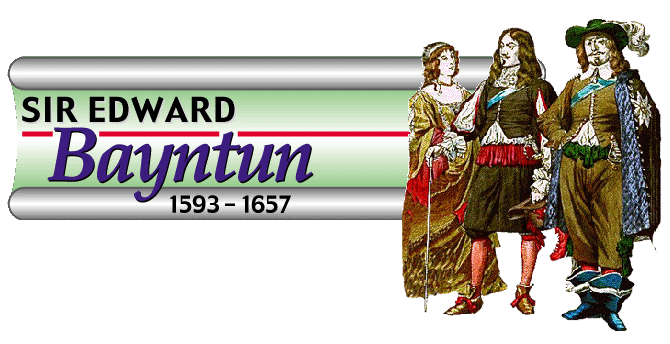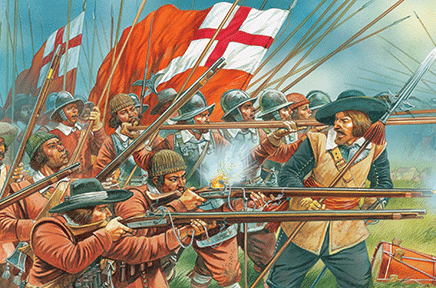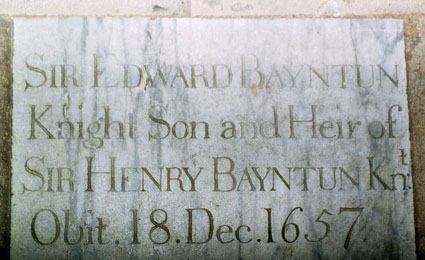
|
Timeline 1619: 1625: |
First Marriage:
Second Marriage:
Edward Bayntun was born at Bromham House and baptised on the 5th September 1593, at Bremhill, in the county of Wiltshire and matriculated at Christ Church, Oxford on the 27th April 1610 but is not recorded as taking a degree. Many documents refer to him as Sir Edward Baynton, however his memorial stone is clear evidence that the family changed the spelling of their surname to Bayntun sometime around the beginning of the 17th century. On the 18th July 1613 Edward married Elizabeth Maynard, the daughter of Sir Henry Maynard of Easton Lodge. This marriage was held at Little Easton, Essex and was knighted in the same year. Edward and Elizabeth had nine children – some of which died at a very young age. Twins, Elizabeth and Lucy, were born in 1615, but did not survive long. Elizabeth died the day after she was born and Lucy was just seven months old when she died. Their first son, Henry, was born two years later in 1617 but died at the age of just two. In 1618 they had a second son, which they called Edward and when Henry died in 1619, Edward became heir. The name Henry must have been very important to Sir Edward and Elizabeth and no doubt the first born Henry was named after Sir Edward's father. in 1621 another son was born and he too was christened Henry. Anne was born in 1622 and another son, Charles born in 1624, who lived for only 3 months. In 1625, William was born but he too died young at just four years of age. Their last child, Mary was born in 1628. After the death of his father, Sir Edward Bayntun in 1616, Edward inherited the Manor of Bromham. He was a Burgess of Devizes from 1614 and a common council man of the town 1621-1626; a Justice of the Peace for Wiltshire from 1619-1642 and again 1650-1657 and for Devizes 1640-1657; DL for Wiltshire 1626-1631; High Sheriff of Wiltshire 1637-1638; MP for Devizes 1614 and 1624-1625; for Wiltshire in 1621-1624 and for Chippenham in 1626, and again from 1640 to 164. He was a Commissioner for the repair of St. Paul's Cathedral in 1633 and served on numerous other commissions in the 1620's and 1630's. He was a Colonel of the Wiltshire horse militia by 1626 and in the 1640's he was an active Parliamentarian. He was a Commissioner in the Trial of Charles I, but did not act. His hostility to the court manifested, that in the Protestation of 1640, his name appears second in the list, being the first after that of Mr. Speaker Lenthall. He sat in every parliament but one up to 1653, having first been elected for Devizes in 1614. Evidence exists in town records that King James I visited Sir Edward's house at Bromham three times in 1618, 1620 and stayed there again from 29th to 31st July 1623. In 1618, the Chamberlain's books from the Devizes Corporation show that certain items were lent to Sir Edward for this visit to Bromham House and that the Corporation paid for the wine given to the King's Trumpeters. A deed dated the 20th March 1624 shows that Sir Edward was a founder of the Salisbury Races, and to stimulate its continuance, he established a silver cup to be ran yearly, in the days of King James I, which after his death, was continued under the trusteeship of the Mayor of the town. Between 1625 and 1630, King Charles I set up schemes for disafforestation in order to raise money. The cleared land was then enclosed and sold. This caused great hardship for those living on the edge of the forests and there was much conflict with the authorities. This "Miniature Civil War" was marked by a noticeable lack of co-operation towards the authorities by influential people, including Sir Edward Bayntun, who refused the Sheriff's call for assistance, telling him "that he did not much fancy that service". In 1631 Edward Bayntun was awarded the title Knight Bachelor of Wiltshire. His private life was quarrelsome, self-interested and dissolute and he fell out frequently with members of his family, including a bitter dispute with his widowed mother, Lucy (Danvers) Bayntun and her nephew Sir John Danvers, his tenants and the neighbouring gentry. To them, he was the "Landlord from Hell". He displayed little respect for authority and was frequently involved in litigation, when he thought nothing of intimidating witnesses, packing juries, seizing goods by force and assaulting officers of the Crown, He was clearly a dangerous man, especially as he did not lack personal courage and was a confirmed duellist. He was charged before the High Commission with having seduced his wife's 15 year old maid with whom he fathered two illegitimate children, having promised to marry her when his wife died. He deserted the girl in 1629 and when her father petitioned the Crown for relief, at least one other child and several mistresses were brought to light, but he secured a royal pardon from King Charles for his adulteries in the following December. He was evidently a very dangerous man with an arrogant and uncertain temper and for much of the history of the Civil War in Wiltshire we hear of his angry rivalry with his neighbours, particularly Sir Edward Hungerford, a fellow parliamentarian and in 1642 each man successfully arrested and escaped from the other. Many on his own side thought him treacherous and was generally regarded with suspicion and even his public career, both in County Government and as an M.P. was fraught with disputes. In 1633, the Manor of Avebury, with lands at Catcomb which were attached to it, were purchased by Sir Edward from William Dunch. He conveyed it to his son Robert – one of the twins born to his second wife Mary. Robert eventually sold Catcomb in 1682 to Matthew Barley of Lockerley, Hants. It was known then as the Manor of Catcomb and separate to the original Manor of Avebury. Also in 1633, a government agent trying to carry out a Royal Commission on the clothing industry complained bitterly of the obstruction offered at Bromham by Sir Edward Bayntun. Sir Edward's first wife, Elizabeth, died on 30th March 1635 and he later re-married Mary Bowell of Cokethorpe, Oxfordshire at St. Peter Paul's Wharf, London on 30th March 1640. She is thought to have been the daughter of Nicholas Bowell (1568-1623) of Chesterton, who was a Yeoman of the Great Chamber. Mary bore him three children – a girl (who died young) and twin boys, whose names are mentioned on their motherís monument (see description at bottom of page). In October 1642
he became Commander-in-Chief for Wiltshire County and he commanded
a force for Parliament in the early part of the Civil War and was
a Commissioner of the English Parliament to reside in the Scots Army.
Devizes was fortified by Sir Edward for parliament and its magazine
enlarged. Sir Edward's
nomination to so important a post in the county of Wilts was manifestly
dictated by feelings of personal regard, with him having already held
military office under two Earls of Pembroke for 20 years past. Though
he was not destitute of the influence which wealth and long standing
in the county gave to his family, yet the reputation which he at the
same time bore among good fellows, or as they were then termed "roaring
boys", seems to have been felt as unfitting him for the post
of leader at so momentous a crisis. Some time prior to the destruction of his house by the fire, Sir Edward had the good sense to seek a securer asylum for his treasures than Bromham House and transferred the bulk of his moveable personal property, consisting of nine trunks full of plate and money to the Isle of Wight, at the time under the government of the Earl of Pembroke. However the estate deeds and papers of earlier generations of the family were destroyed when Bromham House was burnt down in 1645. Whilst there he made some unkind remarks about his former comrades and as a result, Lieutenant-Colonel Carne, Lord Pembroke's Agent, was sent to arrest him. Carne, at the time, wrote: No man hath a fouler mouth than Bayntun for slagging off his comrades. Bayntun was imprisoned in the Tower for a while but was eventually released on the 19th September 1643 to his residence, upon his promise to be a true prisoner to the House. Then on the 24th August 1644 the House of Commons ordered that he have restored unto him all such goods as were seized of his in the Isle of Wight and that all restraint, formerly laid upon them, be taken off. But this did not save his family residence at Bromham House from being taken and burned to the ground by Royalist Forces from Devizes on 5th May, 1645. If he was guilty of treachery it was ironical that the great house at Bromham should have been burnt down by Royalist troops. Bromham House had been empty for some time and it's destruction was deliberate vandalism to prevent it being occupied by the Parliamentary forces. It did nothing to help the Royalist's cause and Colonel Lloyd (Governor of Devizes and Royalist), with a party of horse and foot, came from Devizes to Bromham and utterly destroyed, by fire, one of the most famous buildings in Wiltshire. Sir Edward's other house at Bremhill was also set alight by the Royalist troops and they drove off over 600 of his sheep. After the destruction of Bromham House, the family moved into a smaller house Sir Edward bought, called Spye Park Lodge, to the north of Bromham village and by 1654 Sir Edward had this house enlarged and decorated with carved masonry taken from the ruins of the old house and added some very rich furniture. But before any rebuilding took place, he petitioned for the confirmation of his title to the manor which had been claimed by the Commonwealth Commissioners as having belonged to the Bishop of Salisbury. Sir Edward said that he had lost all his deeds as evidence of ownership when the Royalist's burnt down his houses at Bromham and Bremhill during the Civil War. At this time Bowood Forest was disparked and Sir Edward was granted the deer and it was said they were driven home through a lane made by the weavers with their cloth. The Parliament proceeded to sell the lands which had belonged to the Bishops and amongst these were some at Bishops Canning which Sir Edward claimed as a portion of his estates. The House admitted his title to the Bromham estate, but desired further evidence about the lands at Bishops Cannings John Evelyn mentions in his famous Diaries that he visited the house on the 19th July 1654 before it was completed. He says of his visit: "We went to Sir Edward Bayntun's Spye Park House, north of Bromham village, a place capable of being made a noble seat. But the humorous old Knight has built a long single house of two low stories on the precipice of an incomparable prospect and landing on a bowling green in the park. The house is like a long barn and has not a window on the prospect side". This was where the family continued to live until the mid-19th century. The gateway that was erected at the entrance to Bromham House, as a gift from Catherine of Aragon, had escaped the fire and Sir Edward had it carefully dismantled and re-built once again, on it’s third site, at the entrance to the new house at Spye Park. It stands today as the only evidence of the Bayntun's two fine houses. Originally the gateway was the entrance to Stanley Abbey and is now known to locals as Spye Arch. The tything of Chittoe adjoined the parish of Bromham, but was an outlying part of the Manor of Bishop's Cannings, of which the larger part belonged to the Spye Park estate. This entire manor was purchased by Sir Edward by an underlease from Mr. Robert Henley, Lord Farmer at the time, and this included all rights and property in Chittoe. This comprised of about 100 acres of waste which were added to the new domain called Spye Park, a condition being annexed that day by way of acknowledgement, that Bayntun would pay to the Bishop, as Chief Lord, an annual contribution of two fat bucks. The Spye Park estate paid to the Vicar of Bishop's Cannings every year £2 - 6s - 8d, which may have been the value of the tythes in ancient times, when nearly all the land in tything was waste. A 13th century deed, or Inspeximus, shows the whole of the tythes of this part of the parish were given to the Vicar of Bishop's Cannings and there had previously been an ancient chapel on this land, long since demolished. Sir Edward Bayntun died on the 18th December 1657 and a Warrant was issued to Commissioners some months later in 1658, to receive witnesses at Chippenham on behalf of Henry and Mary Bayntun, the children of Sir Edward, upon an allegation articulate in a cause before the judges for the probate wills, etc., concerning the Last Will and Testament of Sir Edward Bayntun and the evidence so taken to be returned into court, in the Hall of Doctors Commons. This was most likely in relation to a clause in his will, in which Sir Edward listed a desire to have an annuity of £200, to be taken out of the Manor of Bromham, and given to his son Henry. Sir Edward mentioned having actioned this in a former deed, which he could not find at the time of making his last will and the Commission were probably appointed to seek witnesses to this previous deed. (See the full content of his will below). In life, he never suffered the severer penalties which he richly deserved. He did, however, dent the reputation and status of the Bayntuns in the county. From the mid 17th century, they were no longer classed as one of the leading gentry families of Wiltshire. It is assumed he suffered from a mental illness which led to his rebelling against his upbringing, or perhaps as a result of the syphilis to which it seems likely his dissolute behaviour would have exposed him. Apart from their eldest brother, Sir Edward Bayntun, who was his father's heir, Henry and Mary were the only surviving children, at the time of their father's death, from a total of nine children from his first wife, Elizabth Maynard. There is a monument commemorating Mary Bowell, Sir Edward's second wife, in the South Chapel in St. Marks, or the Lord Mayorís Chapel – also called the Chapel of the Hospital of the Gaunts, in perhaps the most ancient church in Bristol. This Baroque style monument shows Dame Mary Bayntun (Mary Bowell) with her two sons kneeling each side of her on pedestals, beneath triple domes holding open draped curtains. The monument was originally in the crossing arch under the tower, but was moved to its present position when renovations were made in the 19th century. Sir Edward Bayntun had land at the time in Barton Regis (that was the name given to the area directly outside the old city of Bristol) in the Lawrence Hill area, which is about 30 miles from Bromham. As this land had been land owned by the Gaunts, she qualified for burial in St. Mark's. There is no other connection between the Gaunts and the Bayntuns. If such had existed, and any of the latter family had, from this cause, used the Mayor's Chapel as a burying-place, surely it would have been some of the earlier male representatives and not merely the second wife and relect of one of them as late as 1667. It is most likely Mary Bowell resided in Bristol after her husband's death, through some connection of her own family with the city. It is also thought that one of her sons was a merchant or possibly Mayor of Bristol which would also account for her burial there. The Latin
inscription on Dame Mary Bayntun's tomb reads:
Robert Bayntun, one of the twins born to Mary Bowell and Sir Edward, went on to be Keeper of the Race Horses at Newmarket some time before 1685, in the reign of Charles II and Keeper of the Running Horses at Newmarket in the reign of William III. Sir
Edward Bayntun's last will was dated 31st October 1657, and reads:
When Sir Edward Bayntun died on 18th December 1657 he was succeeded by his eldest son and heir Edward Bayntun |





